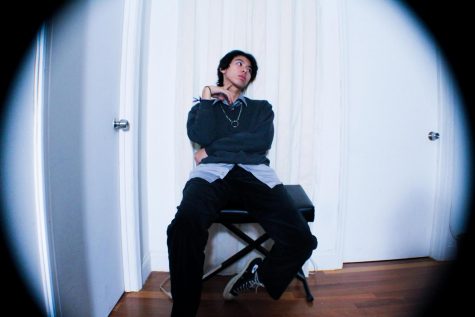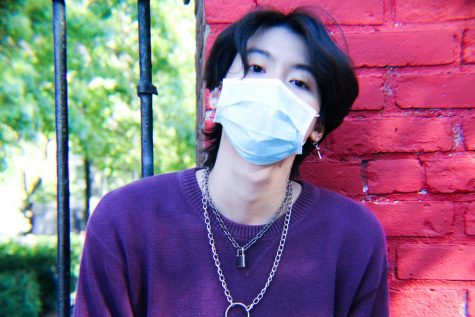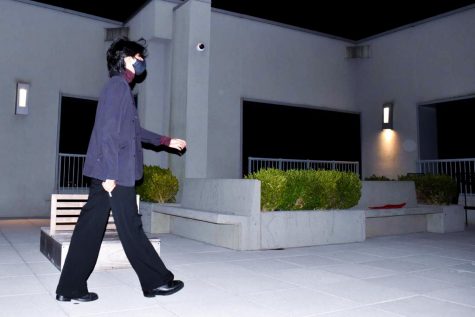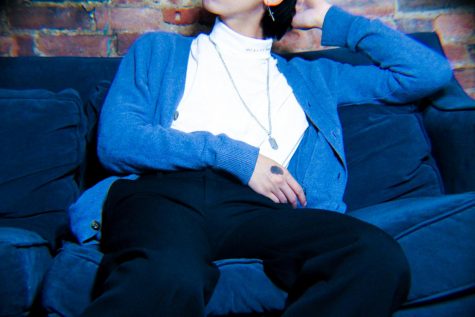




As trends come and go, people are now beginning to appreciate the timelessness of clothes that actually last, won’t just end up in the back of their closet once the micro-season is over or contribute to the destruction of our planet. In their desire to stop supporting fast fashion, many are turning to sustainable means to be fashionable and eco-conscious consumers. One could argue that one of the most trending aspects of the sustainable fashion movement would have to be thrifting and second-hand shopping.
Liberal Studies sophomore Quan Anh Le easily stands out in a crowd for his unique take on fashion, and his friends consider him the go-to person for thrifting advice. One of his most notable looks would have to be his favorite fit and flare pants paired with a trendy, yet super comfy turtleneck and blazer. I remember standing at the entrance to his room, as there was no space to sit down, watching in awe as he pulled out clothes from his wardrobe, which was threatening to burst, and described how he’d managed to keep from resorting to fast fashion shops, yet still keep his budget low. An aspiring runway model who’s had his fair share of street scouting for gigs, Le lives and breathes vintage fashion with a modern twist that will surely appeal to anyone looking for the latest trend.
In this Q&A you’ll discover how Le found his passion for thrifting and the way it helped him dismantle gender norms as a cisgender man, as well as talk about his favorite thrift stores around NYU.
Under the Arch: Why did you start thrifting and how long did it take you to curate your current wardrobe?
Quan Le: My entire wardrobe is the culmination of around four years of buying clothes. I started thrifting in my senior year of high school as a way to differentiate myself from the other kids in my Catholic school in Texas. While I looked a lot better and felt more confident, I was still stuck in the mindset of fitting in. My style drastically changed and became more defined my second semester of my first-year at NYU.
UTA: Where did you get the inspiration to start thrifting and develop your style?
QL: For most of high school, all of my fashion knowledge was from YouTube and Reddit. I’d often peruse subreddits like /r/streetwear and /r/malefashionadvice and YouTubers such as Sangiev, Magnus Ronning and Frugal Aesthetics. Once I got to New York City, I started observing well-dressed people around me and I’d even ‘people watch’ in Washington Square Park. Every single day I would meet people who were so confident in not only what they wore but in themselves as individuals. I felt kind of small and suffered from imposter syndrome. People go to New York to live out their dreams and I was still wearing the same silhouette that gets popular on Instagram. I realized that although I dressed well, it was really safe and said nothing about my essence. This is where my shift from using fashion as a way to fit in and be cool changed into viewing my personal style as an extension of myself. Instead of using clothes to signal my social status – like buying hyped up items or whatever was trendy – I started to participate in it as an art form.
UTA: What makes your wardrobe unique?
QL: Over time, I’ve come to realize that clothes are androgynous. I remember one of my friends telling me that “clothes have no gender” and I didn’t really understand what they meant by that. I wore a tight fitting dress for the first time over summer and I was surprised at how the dress accentuated both my femininity and masculinity. I also realized that a lot of my cis-female friends rock typical men’s clothing. They look so bad-ss in many traditionally masculine clothes ranging from blazers, grandpa button-ups and dad jeans. Fashion is one of the few avenues in which individuals can break societal gender norms and express themselves however they desire and now I am actively manifesting the idea that “clothes have no gender.” Lately, I’m exploring more feminine silhouettes especially ones that make my shape flowy and effortless. I’m confident in all my fits, even if they’re ugly because at least I can have fun trying new things! Fashion should be fun.
UTA: What did you do to the clothes you owned before you began thrifting?
QL: All the clothes I get bored of either become art projects or are given away to friends and family. For example, I recently redesigned a pair of plain, baggy jeans by cutting them up and bleaching them. One of my favorite memories was when my friends would raid my closet and wear my clothes. Since then, we would regularly try on each other’s clothes and the lines differentiating our closets became nonexistent. I can usually look at an article of clothing and intuitively know how to play around with it to create something new. I love how personal thrifting is and the knowledge that these pieces will last.
UTA: What would you suggest people interested in following the latest trends do if they want to thrift instead of buying something new?
QL: I became cognizant of how I dressed and followed trends my sophomore year of high school but by senior year I realized that chasing trends and buying fast fashion was both expensive and harmful to my personal image and the environment. Trends are a good way to start exploring fashion but I believe that following trends too much makes one lose their originality. Look for pieces that resemble the likeness of the trends and try to identify why they’re popular in the first place. For example, sweater vests are trendy and those are easy to make. One could find a relatively inexpensive sweater and use scissors to make it into a vest. Looser pants such as trousers, cargos and jeans are also in trend and thrift stores are the best place to find them.
UTA: What are some of your favourite local thrift stores?
QL: My personal favorites are Beacon’s Closet, Front General Store and 2nd Street. Lately, I’ve been frequenting Beacon’s Closet a lot more; their selection is great as they don’t divide their store into men’s or women’s sections. Their clothes are organized by color and types. I would categorize Beacon’s Closet as bougie on a budget, with a good selection of vintage designer pieces. I found one of my favourite pants there – a pair of vintage flare trousers from Prada. Normally, these would have been in the women’s section as they have a conventionally feminine fit, but because Beacon’s Closet doesn’t assign a specific gender to their clothes I didn’t miss them.
Front General Store specializes in vintage clothing with a focus in grunge and Americana workwear. My best friend and I found this place when we wanted to escape the noise of Manhattan after a really long week. FGS’s selection is highly filtered with only the best quality. The prices are a bit high, but when you’re looking for a pair of vintage french linen trousers from the 1920’s, they’re the only place you can go. These clothes exist outside of trends, their quality and aesthetic speak for themselves, thus standing against the test of time. One of my favorite comfy sweaters is a vintage distressed one from Fred Perry. You can tell that the item has aged very well as the colors have dulled down, yet due to the high quality, its outlived many cycles of washing. Whenever I visit FGS, I always head to the back first to look at the outerwear. There is an insane selection of vintage chore jackets, bombers, jean jackets, work jackets, etc… Basically every single outerwear trend from the past decades. Their sweatshirt selection is really nice too; they all have lasted for many winters.
UTA: What are you usually on the lookout for when you go thrifting?
QL: Fit and Fabric. Fit is the most important thing that you must notice when you buy clothes in general because at the end of the day you’re the one wearing them. Also, I think about how formal/casual the piece is, what vibe it fits and how to incorporate them into the wardrobe I have. Pants are the hardest to thrift but if you find a good pair, they’ll last you for years. Jackets and outerwear are the easiest staple pieces to find while t-shirts are just fun and casual.
UTA: How long do you usually spend in a thrift store finding the perfect piece? Do you often come back empty handed?
QL: I’m a pretty picky shopper; I always weigh out the price and ask myself how long is this going to last me (quality-wise and the time until I’ll get bored of the piece) and see if the price divided by time is worth it. I usually come back empty handed like 70% of the time but I use those opportunities to narrow my taste down even more. I ask myself what I don’t like about certain pieces or what specific details I’m looking for. Usually an hour per session is good but sometimes with a group of friends it can be up to two hours.
UTA: What tips do you have for first timers? QL: Thrift shops are usually on the lower end and have a wider range as they sell donated clothing. They carry a lot more functional, blue-collar clothes. Second hand shops on the other hand usually have a buyer that selects and filters the clothes in the shop, making them slightly higher end. Know your body and before you go thrifting make sure you know how the sizes will fit you. If I want a loose fit, I size up and let the fabric hang off my shoulders. If I want something more contouring to my body shape, I’ll look for my exact size. Knowing your waist size, especially how each size hugs your waist or hip, will make finding pants a lot easier. Knowing how long your torso is will give you a rough idea of the length of the pants. It’s important to understand what you want and don’t want in clothes in order to cater them to your own personal style.
UTA: How do you feel about privilege within thrifting and slow fashion?QL: Personally, I’m very aware of my skinny privilege with regard to fashion and clothes. A lot of sizes I find can and usually do fit me, which makes shopping easier. A big part of my luck thrifting comes from the fact that I can wear both clothes that are true to size and fit me or attempt oversized looks. I believe it’s important to understand that other people don’t have the same privilege, everyone looks different and everyone will need to search for different sizes. I’m trying to be mindful of my privilege by limiting the number of oversized articles I purchase to make sure there are clothes for those members of the community who need bigger clothes.
Email Vaishnavi Naidu at [email protected]
























































































































































